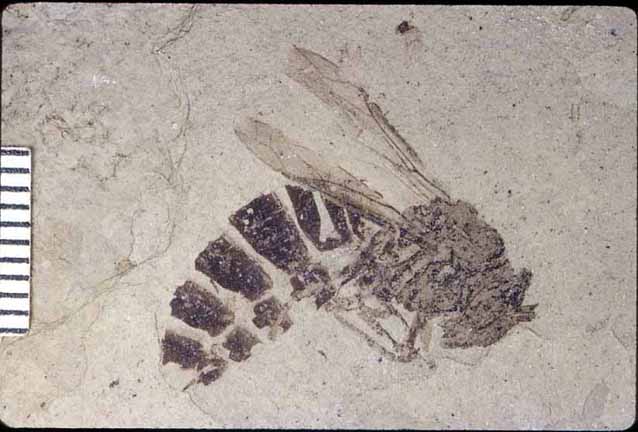 Palaeovespa florissantia, one of the most iconic Florissant fossils, was a paper wasp related to living yellowjackets and hornets. Like its modern relatives, Palaeovespa probably made “papery” gray or brown nests out of plant fibers and saliva. These nests have open honeycomb-like cells for brood rearing, and are anchored to plant stems by a sturdy stalk called a petiole. Modern paper wasps feed on nectar and other insects. They also secrete an ant-repelling chemical around the base of the petiole to keep ants away from their eggs and young.
Palaeovespa florissantia, one of the most iconic Florissant fossils, was a paper wasp related to living yellowjackets and hornets. Like its modern relatives, Palaeovespa probably made “papery” gray or brown nests out of plant fibers and saliva. These nests have open honeycomb-like cells for brood rearing, and are anchored to plant stems by a sturdy stalk called a petiole. Modern paper wasps feed on nectar and other insects. They also secrete an ant-repelling chemical around the base of the petiole to keep ants away from their eggs and young.
 Palaeovespa was described in 1906 by University of Colorado professor T.D.A. Cockerell (learn more), a naturalist with wide-ranging interests. Cockerell collected extensively in the Florissant Formation during the summers of 1906 to 1908, and published over 130 papers on the fossils of Florissant, as well as numerous papers on living insects he collected there, particularly the bees. If you see a bee collecting pollen from a wildflower at the park, that bee was probably described and named by Cockerell–he described more than 900 species in Colorado alone!
Palaeovespa was described in 1906 by University of Colorado professor T.D.A. Cockerell (learn more), a naturalist with wide-ranging interests. Cockerell collected extensively in the Florissant Formation during the summers of 1906 to 1908, and published over 130 papers on the fossils of Florissant, as well as numerous papers on living insects he collected there, particularly the bees. If you see a bee collecting pollen from a wildflower at the park, that bee was probably described and named by Cockerell–he described more than 900 species in Colorado alone!
A stylized image of Palaeovespa decorates the sign at the entrance of the Visitor Center parking lot, and Palaeovespa is also part of the Friends logo. You can buy replicas of this specimen at the Visitor Center gift shop.
“To a non-scientific person it seems highly illogical to say that an object is in one sense of priceless value, and in another only worth ten or fifty cents. The value of a new species of fossil fly or beetle, in a money sense, is of course very small, since neither museums nor naturalists can afford to give large sums for objects which “bake no bread,” and which at the time interest perhaps fewer than half a dozen persons in the world. On the other hand, such specimens form part of the material of science, and essential parts of the great structure of knowledge, and will continue for unknown generations to tell their humble but not insignificant tale of what has been. To lose or destroy them is like removing a brick from some splendid building; the building will not fall, but the offense is intolerable.”
-T.D.A. Cockerell, “Colorado A Million Years Ago,” Journal of the American Museum of Natural History (1916)
-Melissa Barton
Photo Credits: NPS/Florissant Fossil Beds National Monument (Palaeovespa), Michael Apel (living paper wasp and nest)
